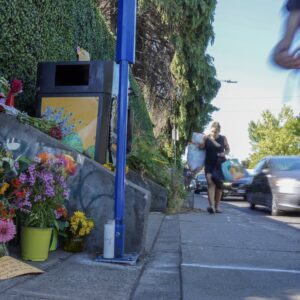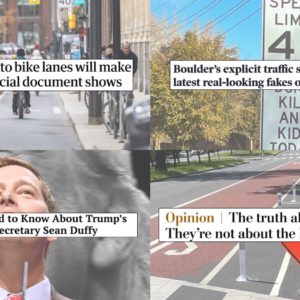Sharon Fekety, the woman who crashed her bike and broke her arm last month while attempting to cross a MAX track, has received a second response (here’s the first) from TriMet GM Fred Hansen.
Fekety wrote Hansen to encourage TriMet to improve their signage and warn bicyclists about potentially dangerous MAX crossings.
Here is an excerpt from Hansen’s response,
“Our management committee that oversees light rail system configuration will discuss at their next meeting a process for reviewing MAX crossing with bike paths and other high frequency bicycle crossings. Because of the concerns you raised in your letter, we are reviewing signage standards to determine the options for alerting cyclists to exercise caution at rail crossings.”
Fekety says she’s hopeful that the review of signage standards will result in signs being placed at dangerous intersections (including the one where she fell) and she plans to follow-up with TriMet on the issue.






Thanks for reading.
BikePortland has served this community with independent community journalism since 2005. We rely on subscriptions from readers like you to survive. Your financial support is vital in keeping this valuable resource alive and well.
Please subscribe today to strengthen and expand our work.
TriMet is lucky right now to not be paying Sharon’s medical bills, and Hansen’s letter indicates they are well-aware of that. Hopefully, Sharon’s experience will cause TriMet to recognize that bikes exist. But it does beg the question of why it took a broken arm and a citizen letter to get TriMet to address an obvious hazard for cyclists.
It boggles my mind that anyone hasn’t realized yet that wet metal is slick. Maybe the city parks dept should also start putting up signs in forest park that say “mud is slippery!”
And if you do fall, and I know I’ve bitten it plenty of times in my bike riding life, get over it, everyone crashes, stop whining and learn to ride.
ouch that stings…
Andre:
I really hope you understand what this country would be like without a system of tort law. It would not be pretty.
I’d rather spend a quick few seconds to slow to a crawl or de-bike at these crossings, than to spend months of pain and re-hab in a sling. The self righteousness shown by the bike community on this topic in the recent past, makes me wonder who they get to wipe up their spilled milk at home.
I commute 100% – year round. That is not to say that I know anymore about staying in the saddle then anyone else – but something I learned many years ago is that in adverse weather, be it wet, cold, icy – whatever – the last thing you want to do is pedal or brake over metal. I go around manhole covers and coast over railroad tracks. That is to say I don’t put any pressure on the wheels. I don’t brake and I don’t pedal over any potential slippery surface. I don’t ride with ego. If I see something greasy or see someone put something greasy on metal – I get off and walk over or around it.
And, not to be insensitive, but common sense should dictate obvious situations.
The good thing is that whatever it takes to call attention to TriMet that, like it or not, bicycles are here and somehow, someway they are going to have to make room to accommodate and respect other forms of transportation.
Thank you Sharon for taking the time to write to Trimet about this issue. I appreciate your willingness to persue Trimet- even after being brushed off by their first letter. Thank you especially for using a thoughtful and respectful way of dealing with the tracks issue- its encouraging to know that others are doing positive things for the bicycle community without making the larger Portland community angry.
The tracks seem like a common problem for cyclists including myself. I was lucky to have only bruises, but I know of 2 people who have been hospitalized from the tracks, 2 who currently have hand/wrist injuries, and several others who were ‘lucky’ like me.
I hope to hear the outcome of Trimet’s meeting and hope that there are safety improvements.
Why is Tri-Met and the Max being singled out here? I cross two sets of tracks on my commute one Max and one Union Pacific. Shouldn’t we contact Union Pacific about putting up signs where their tracks cross a bike lane?
Also warning should be given to ODOT as the paint they use to mark the separation of the bike lane from traffic is slick when wet.